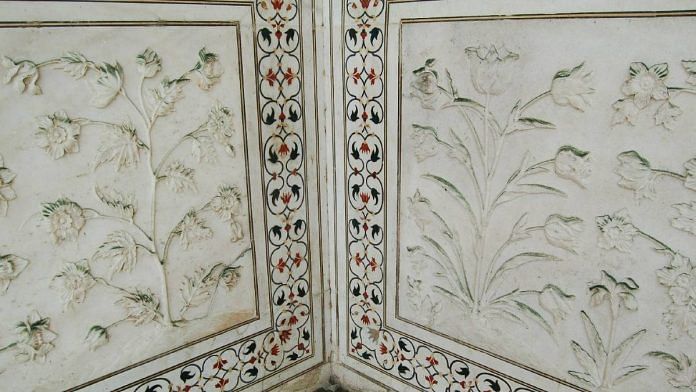Agra: Parts of the Taj Mahal’s pearly-white exterior are turning green, yet again this summer. According to the Archaeological Survey of India (ASI), the culprit is an insect species that is depositing its droppings on the historical monument’s marble surface.
ASI Superintending Archaeologist Raj Kumar Patel told ThePrint that this is a “minor issue that can be easily resolved with some water and cotton”. But environmentalists have raised concerns about what they say is the root cause of the problem: the sewage-filled waters of the Yamuna — on whose banks the mausoleum is located — which is the insects’ breeding ground.
Attributing the greenish spots on the Taj’s surface to the accumulation of excreta of the Chironomus Calligraphus (Goeldichironomus) insect species, the ASI claimed that there was no immediate solution to the problem as the insects bred in the Yamuna.
Speaking to ThePrint, Dr. Praveen Sharma, assistant professor of zoology at BSA (PG) College, Mathura, said that over the past 8-10 years, pollution levels in the river have risen drastically, thereby slowing down water flow and giving rise to swampy conditions near the banks.
The Chironomus Calligraphus is known to have a short breeding cycle, he explained. Warm temperatures, combined with stagnant water on the riverside, make it ideal ground for these insects to breed. Since the males exhibit swarming behaviour for mating, and are attracted to light, the pristine white surface of the Taj Mahal, shining in the moonlight, acts as a natural beacon, attracting the insects to swarm on its surface.
As the area around the Taj is dark and there is no artificial lighting nearby, the monument becomes inundated with these insects that deposit their excreta on its surface. The droppings turn green after a while, Dr Sharma added.
Meanwhile, Dr Girish Maheshvri, head of the entomology department at St John’s College, Agra, told ThePrint that these insect grow in numbers when pollution levels of water bodies rise. “They form a swarm and are attracted towards sand (stone). The swarming is a result of nuptial flight among the insects. They are attracted towards the Taj. The greenery on the monument’s white marble is partially digested chlorophyll combined with their fecal matter. I don’t think this will cause damage to the stone.”
Sandeep Arora, president of the Agra Tourism Development Foundation, said that back in 2016, when this problem had been first noticed, environmentalist D. K. Joshi had petitioned the National Green Tribunal, seeking an immediate check on dozens of open drains pouring into the Yamuna, which were polluting the river and giving rise to “explosive breeding” of these insects in the water. The then Uttar Pradesh chief minister Akhilesh Yadav had ordered a probe into the discolouring of the historic monument and asked the authorities to find the root cause and solution to it.
“However, there was hardly any action on this matter apart from the ASI applying a ‘mud pack’ on the surface of the Taj Mahal, which is akin to beauty treatment of skin that is ailing from within,” he told ThePrint.
According to Arora, the main problem behind this proliferation of insects is that the Yamuna itself is dying. “There are hardly any fish left in the Yamuna, and those that are left, prefer to stay in the middle of the stream where the water is deeper and more free flowing. So in the absence of predators, the riverside becomes a breeding ground for all kinds of insects, including mosquitos.”
Also Read: Single-use plastic is everywhere in daily life. Good news is reuse trend finally back
‘Issue restricted to river-facing side of Taj’
ASI superintending archaeologist Patel, quoted earlier, said: “From March to June, when the river dries up, the insects rise to nest on the marble surface of the Taj Mahal, carrying minuscule amounts of algae on their feet. When the insects leave, the algae remains stuck on the Taj Mahal’s surface and makes it turn greenish.”
He added that staff regularly clean off these green marks with water and cotton washcloths, while harder stains are removed with distilled water. “The stains that resist simple wash are referred to the science branch of the ASI which uses mild chemicals to remove these stains without causing damage to the marble surface.”
Patel claimed that this is not a uniform problem all over the monument and is restricted only to the riverside face of the Taj Mahal. “In fact, the north-eastern minaret of the Taj and the engravings on the monument’s lower facade in that corner are the worst affected areas and are continually cleaned by the ASI staff,” he said.
“The only solution to this problem is to increase the water flow in the Yamuna and reduce the pollution levels in the river water, which is giving these insects an ideal environment to breed behind the Taj Mahal,” he added.
(Edited by Geethalakshmi Ramanathan)
Also Read: India was 8th most polluted country in 2022, with PM2.5 levels 10 times the WHO limit: IQAir report



